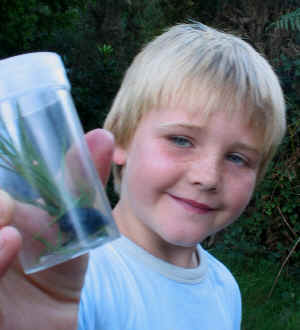
The Young Rangers' Club
A Club for Children interested in Wildlife & Conservation
Nature Detectives
1st September 04

| Wildlife is sometimes difficult to spot unless you
know how and where to look for it. In this meeting we started learning how to be nature
detectives. First of all, Harry brought in some very interesting finds for everyone to look at. One of these was the discarded outer skeleton of an intriguing insect. This skeleton required the use of our detective skills almost immediately!
Identifying the skeleton took more detective work after the meeting. After some research, the skeleton was found to be that of a cicada nymph. (A nymph being the young stage.) While adult cicadas live on trees, the nymphs feed on roots underground. This explains their very large front legs, which are used for burrowing and digging. The front legs are quite different in the adult, because it has no need to dig. More detective work was now required, because cicadas live mainly in tropical areas. They are very rare in England and only one species is found. This species is called the New Forest Cicada (Cicadetta montana) and it is only known from the New Forest, in Hampshire. Harry had told us that the skeleton was given to him by his neighbour in Honiton. Now we wondered, had New Forest Cicadas come to Honiton?! Another enquiry revealed that Harry's neighbour had found the skeleton in France, which being warmer, has several species of cicada. So cicadas had not arrived in Honiton and the puzzle was finally solved. However, it shows that one needs detective skills to find out about wildlife! Continuing the theme of skeletons, Harry had also brought in the skull of a rabbit for the other Rangers to look at.
After looking at the skeletons, Ranger Alan led us on a nature hunt to the Heathland Project Area at the Centre. We were to help get some information on the animals which live on the heathland.
|
|||||||||